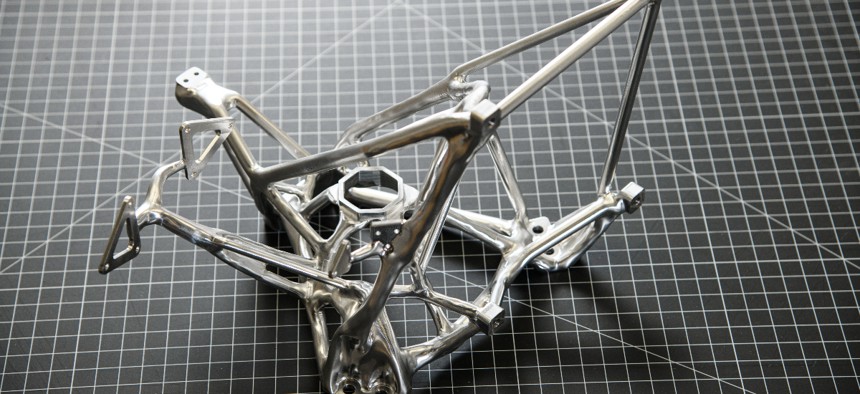NASA Uses AI to Design Mission Hardware

Defined by a human designer, and filled in by an artificial intelligence program, this scaffold was milled from a solid block of aluminum and features connections for mirrors and instruments as well as pathways preserved for laser light and human hands to attach and adjust sensors. Henry Dennis/NASA
The artificial intelligence-assisted components are lighter and can handle higher structural loads than human-designed components, according to the agency.
NASA is using artificial intelligence to design mission hardware for the improved functionality and manufacturing benefits it provides, according to an announcement on Thursday.
NASA noted that while the AI-designed spacecraft and hardware may look like “bones left by some alien species,” they are lighter, can handle higher structural loads and need a lot less time to develop than parts made by humans.
“They look somewhat alien and weird,” said research engineer Ryan McClelland, who pioneered the design. “But once you see them in function, it really makes sense.”
McClelland created the design of “specialized, one-off parts using commercially available AI software” at NASA’s Goddard Space Flight Center.
In order to make these parts, a computer-assisted design specialist begins with the mission’s requirements and draws in the surfaces where the part connects to the instrument or spacecraft, in addition to any bolts or fittings for electronics and other hardware. The CAD designer may also need to block a path so the AI does not obstruct a laser or optical sensor. Some more challenging builds could need room for technicians’ hands to maneuver to help assemble and align the piece.
According to the announcement, once the off-limits areas are defined, the AI connects the dots to produce the design in as little as an hour or two, but the whole process—design analysis, prototype fabrication to final product—can take about a week.
The parts are about one-third of the weight of traditional components and they can be made by commercial vendors.
“The algorithms do need a human eye,” McClelland said. “Human intuition knows what looks right, but left to itself, the algorithm can sometimes make structures too thin.”
The parts are analyzed using NASA-standard validation software and processes to determine possible failure points.
“We found it actually lowers risk,” McClelland said. “After these stress analyses, we find the parts designed by the algorithm don’t have the stress concentrations that you have with human designs. The stress factors are almost ten times lower than parts designed by an expert human designer.”
NASA has adopted these components for various missions—such as “astrophysics balloon observatories, Earth-atmosphere scanners, planetary instruments, space weather monitors, space telescopes and even the Mars Sample Return mission”—in several different stages of design and construction.
For example, this has been used to help develop the EXoplanet Climate Infrared TElescope, or EXCITE, mission—a balloon-borne telescope study designed to examine hot Jupiter-type exoplanets orbiting stars. Specifically, “McClelland designed a titanium scaffold for the back of the EXCITE telescope, where the IR receiver housed inside an aluminum cryogenic chamber connects to a carbon fiber plate supporting the primary mirror.” EXCITE will use a near-infrared spectrograph to perform its continuous observations.
As noted by NASA, AI-assisted design is growing, and there is a strong use case for the agency.
“If you’re a motorcycle or car company,” McClelland said, “there may be only one chassis design that you’re going to produce, and then you’ll manufacture a bunch of them. Here at NASA, we make thousands of bespoke parts every year.”
According to the agency, 3D printing with resins and metals will enhance AI-assisted design and allow larger components like structural trusses, complicated systems that move or unfold, or advanced precision optics. Combining AI, 3D printing or additive manufacturing and creating products with local materials—also known as in-situ resource utilization—will further in-space servicing, assembly and manufacturing capabilities, which is important for the nation’s space infrastructure development as defined by the White House’s Office of Science and Technology Policy.
NASA’s Space Technology Mission Directorate’s Center Innovation Fund and Goddard’s Internal Research and Development program are supporting this work.






